Newly-trained nurse Vanessa is fed up after less than a year in the New South Wales state health system.
She regularly cares for six patients during a shift and sometimes as many as eight, despite union calls for nurse-to-patient ratios of no more than one to four on general wards.





